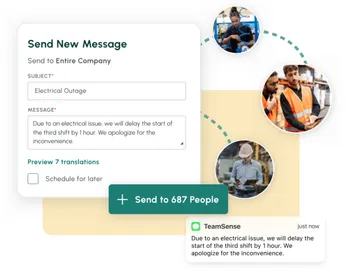When to HR with AI (and When Not To)!
Company
The Pella Corporation is a privately held manufacturer of commercial and residential windows and doors. The Iowa-based company has over 19 manufacturing sites employing over 10,000 employees across the United States.
Challenge
Call-off communication was slow and
manual, impeding production
While Pella has been around for nearly 100 years, its growth from recent acquisitions sparked the need to improve internal communication across the entire family of brands.
LuAnn Shafer manages human resources for the company’s 400-employee facility based in Troy, Ohio. Shortly after she joined the company, LuAnn noticed how inefficient their existing call-off process was.
Employees called off from work by notifying their individual managers. It was then the HR team’s responsibility to collect that information from each manager in order to report on attendance and begin production.
As you can imagine, having to gather all that information from all the different managers did not give us the quick turnaround we needed to report on absentee rates and actually start the production lines. Our call-the off process was impacting our ability to produce products.”
After seeing a demo of TeamSense’s attendance product, LuAnn and her team decided to roll it out in their Troy, OH facility. She recalled TeamSense working hand-in-hand with the Pella team to launch the new call-off line.
SOLUTION
Automating call-offs with TeamSense
For LuAnn, the ability to get instant attendance intelligence for the day was an invaluable benefit. For Pella’s operations, that visibility is critical because it helps them start their shifts on time without risking production slowdowns.
TeamSense’s reporting features also makes it easy for LuAnn to respond quickly to any requests for data coming from their corporate team.
“I now have the data I need right at my fingertips. I can pull up absenteeism rates for any given date range and send that off to Corporate almost immediately. [TeamSense] even breaks it down to who has the highest number of call-ins and what are they calling in for. There’s a lot of good data there.”
As a bonus, there’s been no question that the hourly employees find the new call-off process extremely easy to use. “They love it. They send a quick text, get a link [from TeamSense], and are able to tell us that they’re not going to be in and the reason why. It’s been very beneficial,” she says.
Exploring new communication use cases
When it came to using TeamSense, Pella didn’t just stop at attendance management. Today, Pella also uses TeamSense’s broadcast messages to communicate urgent information to their employees.
“Not too long ago, we had an electrical outage at our facility that caused us to delay the start of our third shift. Without TeamSense, communicating that to hundreds of employees would’ve meant using a phone tree or some other slow and archaic method. We were able to get that message out instantly via text with TeamSense.”
The best part, according to LuAnn, is knowing that those messages are being received by employees because TeamSense always has the latest, most up-to-date contact information.

RESULT
No more scrambling to start shifts.
With TeamSense, Pella is able to run their production lines on time. “Instead of scrambling and seeing who we have missing and who we need to get on site, we can actually run production at startup,” LuAnn says. This gives the site General Manager confidence that they can run their lines lean and save costs.
LuAnn and her team have also saved significant time in their HR operations. She’s now able to devote the time previously used to manage call-offs—about one to two hours per day—to focus on employee engagement strategies. Next up, LuAnn is looking forward to using TeamSense Mobile Forms for an upcoming employee survey initiative she has planned.


